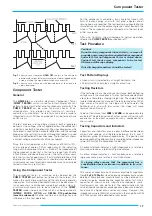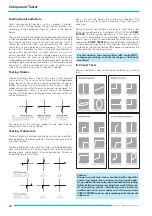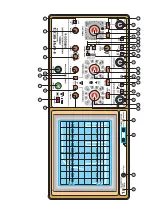
9
Subject to change without notice
If DC voltages are applied under AC input coupling conditions
the oscilloscope maximum input voltage value remains 400V.
The attenuator consists of a resistor in the probe and the 1M
Ω
input resistor of the oscilloscope, which are disabled by the AC
input coupling capacity when AC coupling is selected. This also
applies to DC voltages with superimposed AC voltages. It also
must be noted that due to the capacitive resistance of the AC
input coupling capacitor, the attenuation ratio depends on the
signal frequency. For sinewave signals with frequencies higher
than 40Hz this influence is negligible.
In the GD (ground coupling) setting, the signal path is interrupted
directly beyond the input. This causes the attenuator to be
disabled again, but now for both DC and AC voltages.
With the above listed exceptions
HAMEG
10:1 probes can be
used for DC measurements up to 600V or AC voltages (with a
mean value of zero volt) of 1200Vpp. The 100:1 probe HZ53
allows for 1200V DC or 2400Vpp for AC.
It should be noted that its ACpeak value is derated at higher
frequencies. If a normal x10 probe is used to measure high
voltages there is the risk that the compensation trimmer
bridging the attenuator series resistor will break down causing
damage to the input of the oscilloscope. However, if for
example only the residual ripple of a high voltage is to be
displayed on the oscilloscope, a normal x10 probe is sufficient.
In this case, an appropriate high voltage capacitor (approx. 22-
68nF) must be connected in series with the input tip of the
probe.
Total value of input voltage
The dotted line shows a voltage alternating at zero volt level.
If superimposed on a DC voltage, the addition of the positive
peak and the DC voltage results in the max. voltage (DC +
ACpeak).
With
Y-POS.
control (input coupling to
GD
) it is possible to use
a horizontal graticule line as
reference line for ground
potential
before the measurement. It can lie below or above
the horizontal central line according to whether positive and/
or negative deviations from the ground potential are to be
measured.
Time Measurements
As a rule, most signals to be displayed are periodically repeating
processes, also called periods. The number of periods per
second is the repetition frequency. Depending on the time
base setting of the
TIME/DIV.
switch, one or several signal
periods or only a part of a period can be displayed. The time
coefficients are stated in
s/div.
,
ms/div.
and
µs/div.
on the
TIME/DIV.
-switch. The scale is accordingly divided into three
fields.
The duration of a signal period or a part of it is determined by
multiplying the relevant time (horizontal distance in div.) by the
time coefficient set on the
TIME/DIV.
-switch.
The variable time control (identified with an arrow knob
cap) must be in its calibrated position CAL.
(arrow pointing
horizontally to the right).
With the designations
L
= displayed wave
length in div.
of one period,
T
=
time in seconds
for one period,
F
= recurrence
frequency in Hz
of the signal,
Tc
=
time coefficient in s/div.
on time base switch and
the relation
F = 1/T
, the following equations
can be stated:
With depressed X-MAG. (x10) pushbutton the Tc value must be
divided by 10.
However, these four values are not freely selectable. They
have to be within the following limits:
L
between 0.2 and 10div., if possible 4 to 10div.,
T
between 0.01µs and 2s,
F
between 0.5Hz and 30MHz,
Tc
between 0.1µs/div. and 0.2s/div. in 1-2-5 sequence
(with
X-MAG. (x10)
in out position), and
Tc
between 10ns/div. and 20ms/div. in 1-2-5 sequence
(with pushed
X-MAG. (x10)
pushbutton).
Examples:
Displayed wavelength L = 7div.,
set time coefficient Tc = 0.1µs/div.,
required period T = 7x0.1x10
-6
= 0.7µs
required rec. freq. F = 1:(0.7x10
-6
) = 1.428MHz.
Signal period T = 1s,
set time coefficient Tc = 0.2s/div.,
required wavelength L = 1:0.2 = 5div..
Displayed ripple wavelength L = 1div.,
set time coefficient Tc = 10ms/div.,
required ripple freq. F = 1:(1x10x10
-3
) = 100Hz.
TV-line frequency F = 15625Hz,
set time coefficient Tc = 10µs/div.,
required wavelength L = 1:(15 625x10
-5
) = 6.4div..
Sine wavelength L = min. 4div., max. 10div.,
Frequency F = 1kHz,
max. time coefficient Tc = 1:(4x10
3
) = 0.25ms/div.,
min. time coefficient Tc = 1:(10x10
3
) = 0.1ms/div.,
set time coefficient Tc = 0.2ms/div.,
required wavelength L = 1:(10
3
x0.2x10
-3
) = 5div.
Displayed wavelength L = 0.8div.,
set time coefficient Tc = 0.5µs/div.,
pressed X-MAG. (x10) button: Tc = 0.05µs/div.,
required rec. freq. F = 1:(0.8x0.05x10
-6
) = 25MHz,
required period T = 1:(25x10
-6
) = 40ns.
If the time is relatively short as compared with the complete
signal period, an expanded time scale should always be
applied (
X-MAG. x10
button pressed). In this case, the
ascertained time values have to be divided by
10
. The time
interval of interest can be shifted to the screen center using
the
X-POS
. control.
Type of signal voltage










































